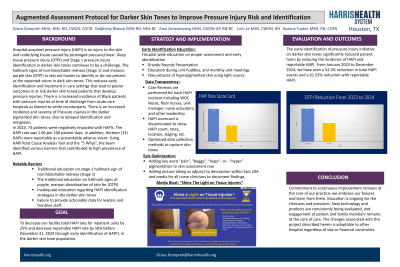Evidence-Based Practice
(EBP-005) Augmented Assessment Protocol for darker Skin Tones to Improve Pressure Injury Risk and Identification
Friday, May 2, 2025
7:45 PM - 8:45 PM East Coast USA Time

Dalphany Blalock, MSN; Ama Acheampong, MSN CWON-AP RN-BC – WOC Nurse; Linh Le, MSN CWON – WOC Nurse; Kyanna Tucker, MSN – Medical ICU Manager
Introduction: Deep tissue pressure injury (DTI) and Stage 1 pressure injury identification in darker skin tones continues to be a challenge. The hallmark signs of non-blanchable redness (Stage 1) and maroon, purple skin (DTI) in skin are harder to see or do not present as the expected colors in dark skin tones. This reduces early identification and treatment in care settings that lead to poorer outcomes in at risk darker skin toned patients that develop pressure injuries. The Acute Care Services department which includes the Wound Ostomy Continence Nurse team, Intensive care units, medical surgical and intermediate care units undertook an initiative to improve pressure injury identification in darker skin tones.
Methods: After literature review and previous year root cause analyses, a new initiative that included education on darker skin tone assessment pearls, and the “shine the light” protocol were instituted. These were added to the skin assessment and 2RN skin protocol of the hospital. It highlighted the critical need for augmented assessment of darker skin tones to include the use of alternative light source, pain assessment, importance of palpation and temperature assessment. Other tools and interventions were leadership rounding, Braden scale, Plan-Do- Check-Act and Root cause analyses.
Results: This intervention and adopted process led to a decreased hospital acquired pressure injury rate from 1.06 in 2023 to 0.52 in 2024 (per 1000 patient days). Our compliance with the shine light protocol is 85%. We had an increased identification of DTIs and Stage 1 pressure injuries. Decrease in advance staged DTIs Some key factors that contributed to the success of the project include specific customized staff education; closed loop communication; WOC Nurse open door policy; unit leadership engagement and monthly reports to quality
Discussion: This initiative led to more accurate skin assessment across skin tones for equitable care. Accurate skin assessment leads to early identification of skin changes and pressure injuries for early intervention which improves patient care quality and increases the impact we make to care for at-risk patients.
Methods: After literature review and previous year root cause analyses, a new initiative that included education on darker skin tone assessment pearls, and the “shine the light” protocol were instituted. These were added to the skin assessment and 2RN skin protocol of the hospital. It highlighted the critical need for augmented assessment of darker skin tones to include the use of alternative light source, pain assessment, importance of palpation and temperature assessment. Other tools and interventions were leadership rounding, Braden scale, Plan-Do- Check-Act and Root cause analyses.
Results: This intervention and adopted process led to a decreased hospital acquired pressure injury rate from 1.06 in 2023 to 0.52 in 2024 (per 1000 patient days). Our compliance with the shine light protocol is 85%. We had an increased identification of DTIs and Stage 1 pressure injuries. Decrease in advance staged DTIs Some key factors that contributed to the success of the project include specific customized staff education; closed loop communication; WOC Nurse open door policy; unit leadership engagement and monthly reports to quality
Discussion: This initiative led to more accurate skin assessment across skin tones for equitable care. Accurate skin assessment leads to early identification of skin changes and pressure injuries for early intervention which improves patient care quality and increases the impact we make to care for at-risk patients.

.jpg)